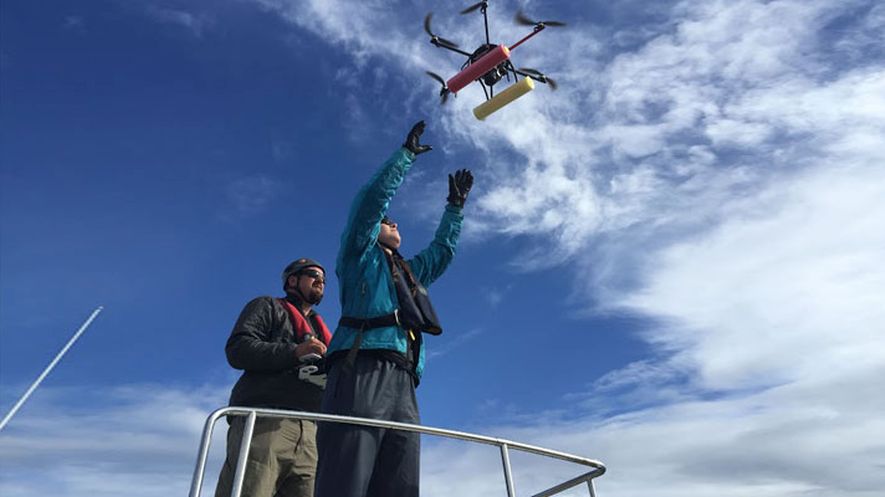A NOAA Fisheries research team flying a remotely operated hexacopter in Washington’s San Juan Islands in September collected high-resolution aerial photogrammetry images of all 81 Southern Resident killer whales that showed the endangered whales in robust condition and that several appear to be pregnant.
Photogrammetry is the science of making measurements from photographs and has proven to be a powerful method for understanding the health of whales and other wildlife. Researchers can readily identify individual killer whales from the distinctive shape of their dorsal fin and saddle patch from the air or water, allowing them to track the condition of individual whales over time. Following analysis, individual growth and body condition from this year will be compared to previous photogrammetric assessments in 2008 and 2013 to assess changes.
The thousands of photogrammetry images collected to date provide important baseline information about the condition of the whales as a warm El Niño climate pattern takes hold along the West Coast following more than a year of already unusually warm ocean temperatures. El Niño and warm ocean conditions have in the past led to declines in salmon, the favored food of Southern Residents.
“Most individuals appear to be fairly robust this year, which is good news, but it’s also very important baseline information to have if the next few years turn out to be difficult for salmon and their predators,” said biologist John Durban of NOAA Fisheries’ Southwest Fisheries Science Center, who piloted the hexacopter on 115 flights totaling about 23 hours over the Southern Resident killer whales.
The flights were part of a joint photogrammetry project conducted by the Southwest Fisheries Science Center and the Vancouver Aquarium to collect high-resolution images of both Southern Resident killer whales and neighboring Northern Resident killer whales around Vancouver Island.
“We have typically counted births and deaths to assess population status, but photogrammetry gives us a new tool to better assess the whales’ condition between years and to look for changes over the course of the year,” said Lynne Barre, branch chief for protected resources in NOAA Fisheries’ Seattle office.
Scientists previously collected photogrammetry images in 2008 and 2013 using helicopters, which flew at 750 to 1,000 feet compared to the hexacopter that flies at 100 to 120 feet. The hexacopter weighs about 4.5 pounds, with a roughly 30-inch wingspan, and carries a special camera system designed at the SWFSC. The small, quiet aircraft allows researchers to collect high-resolution images at a much lower altitude without disturbing the whales.
Photogrammetry efforts in 2008 and 2013 documented a decline in the overall body condition of the Southern Resident killer whales, as well as the apparent loss of calves by some pregnant females.
Initial examination of this year’s data suggests improved condition for some whales, offering hope for the population. Researchers plan to use photogrammetry to monitor the condition of Southern Resident killer whales again next year and in different seasons to determine whether they face shortages of salmon prey at certain times of the year. Seasonal photogrammetry data will help NOAA Fisheries prioritize salmon recovery actions to improve salmon numbers at the times of year when the whales may be food-limited, Barre said.
A 2014 NOAA Fisheries Special Report on Southern Resident killer whales identified limited prey availability as one of three main threats to the whales, in addition to chemical contaminants and vessel traffic and noise.
All flights over whales were conducted under permit from NOAA Fisheries with air space clearance from the Federal Aviation Administration.
More imagery and background is available online.
Podcast and new aerial photos of killer whales here.
Hexacopter research on killer whales video here.



